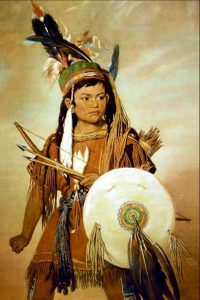Indiánská výchova dětí – chlapci. / Indian education of children – boys.
Indiánské děti byli vedené k úplně jinému pojetí života, než naše dnešní děti. Byli vychovávané k vědomí, že jsou součástí přírody – k pocitu, že nikdy nejsou samy, protože vždy jsou s nimi aspoň jejich příbuzní, stromy, skály a vítr. Z toho vyplíval pocit zodpovědnosti za stáda buvolů, neochota zbytečně zabíjet a odpor proti mrhání dary přírody.
Výchova se v jednotlivých kmenech zakládala na jednotných principech.
V kmenech Sioux, jako byli třeba Oglalové, se děti cvičily v odolnosti, výdrži, statečnosti a sebeovládání. Učily se znalostem potřebným k životu v přírodě – například po probuzení natřeli chlapci tvář na černo a dostal za úkol ulovit nějaké malé zvíře jako veverku, křepelku nebo zajíce. Nedostal najíst pokud nesplnil úkol – černá tvář oznamovala ostatním, že mu nemají pomáhat ani mu dát najíst. Malí pětiletí až sedmiletí chlapci byli hrdí na to, že uměli odolat bolestem, námaze a strachu. Cílem prospěchu jedince byl prospěch celého kmene.
Výchova dětí nebyla nikdy usnadněna – dítě kmene Oglala bylo vždy vystaveno podmínkám, které byly na hranicích jeho schopností.
Chlapci se učily znát všechny přírodní jevy – vítr, hmyz, rostliny, skály – a být na ně citliví. Přístup ( a učení ) nebyl ve formě teoretického studia, ale používaná forma seznamování se a navazování přátelství. Všechny jevy měly údajně nějaké vlastnosti, které dítě také rádo mělo. Děti se učily jednat z vlastní iniciativy a dospět k vlastním rozhodnutím, která byla respektována ostatními. Odmalička byli děti povzbuzovány, aby dávaly dary.
Vladimír Tomek – Tom
Indian children were led to a very different conception of life than our children today. They were raised by the knowledge that they are part of nature – the feeling that they are never alone, because they are always with them, at least by their relatives, trees, rocks and wind. Vyplíval sense of responsibility for the herd of buffalo, reluctance to unnecessarily kill and resistance against squandering the gifts přírody.b
Education in the various tribes based on uniform principles.
The Sioux tribes, as they need Oglalové, children are trained in endurance, stamina, courage and self-control. They learned the skills needed to live in nature – for example, after waking the boys face painted black and given the task to catch some small animal like a squirrel, rabbit or quail. Did not eat if you did not fulfill the task – black face notify others that do not help him or give him something to eat. Little five-year to seven-year boys were proud that they could withstand the pain, exertion and fear. The aim of the benefit of the individual, the benefit of the whole tribe.
Raising children has never been easier – child Oglala tribe has always been exposed to conditions that were on the border of his abilities.
The boys learned to know all natural phenomena – wind, insects, plants, rocks – and be sensitive to them. Access (and learning), not as a theoretical study, but used form of dating and making friends. All the events were supposed to have properties that child also likes it. Children were taught to act upon their own initiative and come to their own decision, which was respected by others. Childhood children were encouraged to give donations.
Vladimir Tomek – Tom
Education in the various tribes based on uniform principles.
The Sioux tribes, as they need Oglalové, children are trained in endurance, stamina, courage and self-control. They learned the skills needed to live in nature – for example, after waking the boys face painted black and given the task to catch some small animal like a squirrel, rabbit or quail. Did not eat if you did not fulfill the task – black face notify others that do not help him or give him something to eat. Little five-year to seven-year boys were proud that they could withstand the pain, exertion and fear. The aim of the benefit of the individual, the benefit of the whole tribe.
Raising children has never been easier – child Oglala tribe has always been exposed to conditions that were on the border of his abilities.
The boys learned to know all natural phenomena – wind, insects, plants, rocks – and be sensitive to them. Access (and learning), not as a theoretical study, but used form of dating and making friends. All the events were supposed to have properties that child also likes it. Children were taught to act upon their own initiative and come to their own decision, which was respected by others. Childhood children were encouraged to give donations.
Vladimir Tomek – Tom
http://www.ihned.cz/c1-51982170-jsou-indianske-deti-stastnejsi-nez-nase
Obrázky z wikipedie a internetu.
Pictures from Wikipedia and the Internet.



